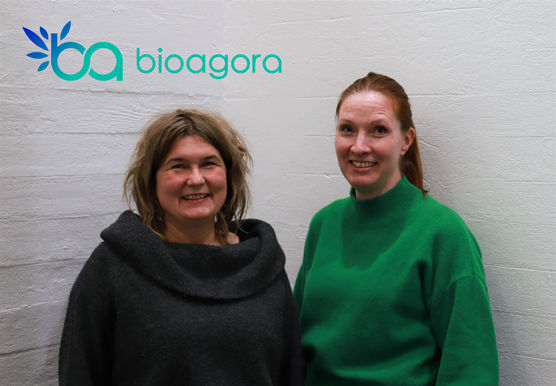
Group managers Kati Vierikko and Kaisa Korhonen-Kurki. © Image: Maija Airos.
The Finnish Environment Institute (Syke) coordinates multiple international research and innovation projects. One of them is BioAgora, a project that started in July 2022. The project is building Science Service for Biodiversity for Knowledge Centre for Biodiversity (KCBD) to ensure that current and future research is used broadly in decision-making concerning biodiversity.
BioAgora project supports the European Union’s biodiversity strategy’s goals and develops methods to utilize research more efficiently in the interface of science and policy. The project lasts five years, and it has 22 partners from 13 countries. The project succeeded in Horizon Europe call where it got funding of 11,8 million euros.
How does one coordinate a project this huge? Answer to this question is given by Finnish Environment Institute’s group managers Kati Vierikko and Kaisa Korhonen-Kurki during the busy kick-off event of the project.
Why is it the Finnish Environment Institute that coordinates the project?
Vierikko starts answering the question by saying that since BioAgora is such a huge project it was important that the coordinating partner is an organization who also has previous experience on projects that focus on the interface of science and policy. Finnish Environment Institute has been, for example, part of creating Alternet, Eklipse and Oppla, which are services based on networks and which aim to promote the use of science in decision-making.
“In Finnish Environment Institute we have a long history in similar topics. In addition, we are known as trustworthy partner in Europe. Less experienced partner would not probably have resources to coordinate project this big. Therefore, it was natural that the coordinating responsibility was given to us”, explains Vierikko.
Both you Vierikko and Korhonen-Kurki are coordinators in the project, how does your roles differ?
“There are multiple coordinators in the project, so everyone has a different task. I, for example, keep in touch with the European Commission and follow that the project and the doings of the work groups go as planned”, Vierikko tells.
Korhonen-Kurki is the project’s scientific co-coordinator. “Me and Marie Vandewalle are the scientific co-coordinators of the project. Marie works in the German Helmholz-Centre for Environmental Research UFZ. Our responsibilities focus on the project’s scientific content and developing different activities to the interface of science and policy.”
What does coordinating the project mean in practice?
“The first task is to focus on getting the project going and making sure that the working groups take on the tasks that are assigned to them. Coordinating a project involves a lot of practical things such as reporting and keeping contact. Coordinating can occasionally be quite demanding, but Syke has organized well support for the coordination of international projects”, Vierikko says.
According to Korhonen-Kurki, the most interesting part of being a coordinator is to see what kind of activities the project can develop to enhance the use of scientific knowledge in decision-making in Europe. Learned lessons from previous experiences and projects are used to develop this. Vierikko thinks that the most interesting part is to keep-up good team spirit and enabling the creation of common ideas.
“I would say that the coordinator is the enabler”, Kati says and continues, “as a coordinator, you need to make sure that everything that is done in the project is done in good spirit. At the same time coordinators need to make sure that all partners are on the same page, and no one is left behind. Coordinators have an important role especially because the Commission has big expectations for the project, and we are building this new and important service.”
Vierikko says that coordinators need to know how to deal with internal conflicts and how to fit differentiating interests together, especially since partners might not always see eye to eye in big projects. In practice, this means having constant dialogue and creating an atmosphere where people feel that they can bring out their opinions. “It’s a coordinator’s job to make sure that the doings of the project are fair to everyone”, Vierikko says.
How does the project fit in with Finnish Environment Institute’s goals?
“Both the Finnish Environment Institute and BioAgora aim to mainstream biodiversity strategy’s goals in Europe”, Vierikko tells, “in addition, one of the main goals of Syke is to stop biodiversity loss and both Syke and Bioagora want that biodiversity science has a stronger role in decision-making.”
“In addition, both the Finnish Environment Institute and BioAgora thrive to ambitious and long-term transformation. To a transformation where biodiversity as a whole is considered in decision-making”, Vierikko adds.
Finally, now that BioAgora has kick-offed, how are you feeling?
Both Vierikko and Korhonen-Kurki are in great spirit. “The whole consortium has a positive mindset and people are excited”, Vierikko tells. Korhonen-Kurki agrees: “The project has started very well, and we have clear plan on how to continue!”
More information
- Group manager Kati Vierikko, Suomen ympäristökeskus SYKE, p. 029 525 2084, etunimi.sukunimi@syke.fi
- Group manager Kaisa Korhonen-Kurki, Suomen ympäristökeskus SYKE, p. 02 95 251 412, etunimi.sukunimi@syke.fi
Views and opinions expressed are however those of the author(s) only and do not necessarily reflect those of the European Union or the European Commission. Neither the European Union nor the granting authority can be held responsible for them.